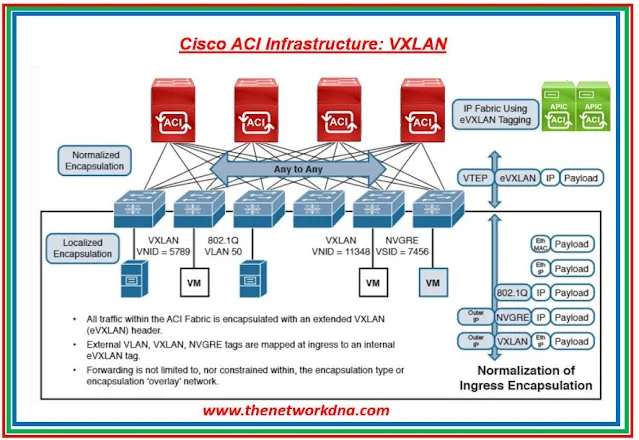Understanding the Physical Requirements of a Cisco ACI Solution
Understanding the Physical Requirements of a Cisco ACI Solution
As you know that the Cisco ACI solution, including the hardware and software components. Cisco ACI solution has following components that need to be ordered
- Application Policy Infrastructure Controller (APIC) 3 node Cluster.
- ACI Fabric Leafs: Cisco Nexus 93XX switches
- ACI Fabric Spines: Cisco Nexus 95XX switches and/or Nexus 9336PQ fixed spine
- ACI licenses for the 93XX leaf switches. No ACI license required for Spines.
- ACI licenses for FEX support
- AVS (Application Virtual Switch) licenses
ACI Fabric Spines: Cisco Nexus 9K switches
ACI Fabric Spines are the high-performance switches that form the core of Cisco's Application Centric Infrastructure (Cisco ACI) architecture.
They provide a highly scalable, low-latency, and high-bandwidth fabric for connecting all devices in the data center, including servers, storage, and other network devices. The spines provide a highly resilient, non-blocking architecture that can handle large amounts of traffic and can be easily expanded to meet growing data center demands.
 |
| Fig 1.2- Cisco ACI Spines Switches |
ACI Fabric Leafs: Cisco Nexus 9K switches
Cisco ACI Fabric Leafs are the access switches in Cisco's Application Centric Infrastructure (Cisco ACI) architecture. They provide connectivity to end-host devices such as servers and storage, and act as intermediaries between the spines and the endpoints.
Leafs in Cisco ACI use a policy-driven approach to configure and automate network connectivity and security policies, reducing manual configuration and improving operational efficiency. They also provide advanced features such as network segmentation and micro-segmentation to enhance security and isolate traffic flows.
Consider the number of leaf ports, and the type of leaf interfaces you plan to deploy.
 |
| Fig 1.3- Cisco ACI Leaf Switches |
Cisco ACI APIC Cluster
The Cisco Application Policy Infrastructure Controller (APIC) Cluster is a group of three or more APIC nodes that work together to provide a single point of management for the Application Centric Infrastructure (Cisco ACI) fabric. The APIC cluster provides a highly available and distributed control plane for managing network policies, and it can dynamically scale to support larger Cisco ACI deployments.
 |
| Fig 1.4- Cisco ACI APIC Cluster |
APIC cluster connects to the fabric edge ports (leafs). You will need following information to choose your configuration
- Number of Cisco ACI enabled Edge ports the APIC controller will be managing (i.e., Total number of leaf ports in the fabric)
- A set of APIC appliances constitute an APIC cluster. Figure out the number of APIC appliances you want to configure in the APIC cluster for scale and redundancy considerations
- APIC appliance connects to the Edge/leaf ports. Pick the RIGHT interface type on APIC cluster to match available interface type on Cisco ACI Leaf switches (Copper or SFP)
- ACI Base licenses: These are the foundational licenses required to operate the Cisco ACI fabric, and they enable features such as network segmentation and policy-based automation.
- ACI Advanced licenses: These licenses provide additional features such as security and micro-segmentation, telemetry and analytics, and multi-site management.
- ACI Cloud licenses: These licenses provide integrations with public cloud providers such as AWS and Azure, allowing customers to extend their ACI fabric into the cloud.
- ACI Anywhere licenses: These licenses enable ACI deployments on non-Cisco hardware or in virtualized environments.
 |
| Fig 1.5- Cisco ACI Leaf License |
 |
| Fig 1.6- Cisco ACI FEX License |
 |
| Fig 1.7- Cisco ACI FEX License |
Continue Reading...
++++++++++++++++++++++++++++++++++++++++++++++++++++
Cisco Nexus Dashboard Cluster Upgrade - The Network DNA
Introduction to Cisco Nexus Cloud - The Network DNA
Cisco ACI: Part 1-Multi-Site Orchestrator Deployment (MSO) - The Network DNA
Cisco Nexus Dashboard Cluster Upgrade by CLI manual Process - The Network DNA
Cisco ACI: Backup and Restore in Nexus Dashboard (MSO) - The Network DNA
++++++++++++++++++++++++++++++++++++++++++++++++++++








